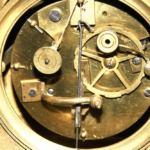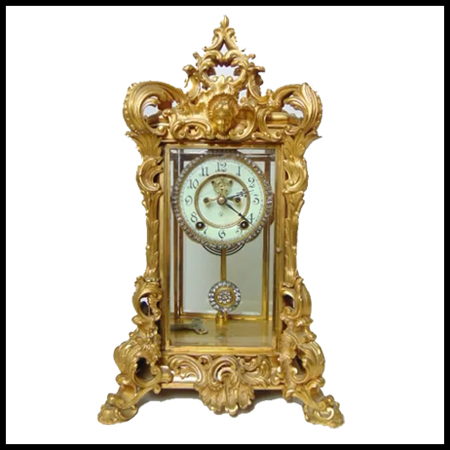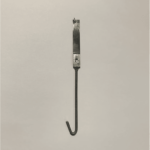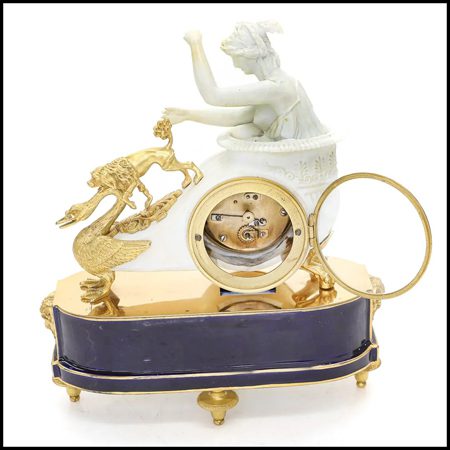Vintage clocks hold a certain charm and allure that transcends the mere telling of time. These timeless pieces are functional and serve as windows into the past, evoking a sense of nostalgia and wonder. If you’re the proud owner of an antique or vintage clock, it’s essential to understand the mechanism in order to keep these treasures ticking and have your old clock running accurately.
Vintage Clock Mechanisms
One of the key aspects of vintage clock ownership is understanding the mechanisms that power them. Unlike modern quartz clocks, vintage clocks often rely on intricate mechanical movements that require regular winding and adjustment. Familiarizing yourself with the inner workings of your clock, whether it’s a grandfather clock, a mantel clock, or a pocket watch, can help you ensure its longevity and proper functioning.
Vintage Clocks: The Pendulum
The Pendulum of a vintage clock may be one of three main types. The older antique clocks operate with a silk string drive, where the pendulum, with a hook at its top, clips onto a string and slots into a forked piece of metal, called a verge, that internally connects to a wheel. When the verge is moved, the wheel is moved, thus driving a vintage clock, and producing the tick/tock one hears.

Around the middle of the 1800’s the silk string mechanism on vintage clocks gave way to a “spring suspension,” which is a flat piece of metal, hanging from the top of the mechanism, via a pin and at its lower end, forming a T from a thin bar at left or right. Moving from the earlier simple “hook,” the top of the pendulum in old clocks, looks like a two-fingered claw with a space in its center to hook over, left and right. As before with the silk string movements, starting the pendulum moving via the verge.
One of the problems with both of the above suspensions is that if the clock is out of balance, one needs to find the correct left-right balance by lifting either end of a vintage clock until the sound of the tick/tock is even. Once the even sound is attained, you then know how to bend the verge. You would bend it towards the same side lifted. A latter-day invention, showing up in vintage clocks near the end of the 19th century with many clocks, was a suspension capable of moving from left to right with an adjustment that did not require bending the verge. However, on very upscale clocks, this was available on those old clocks as early as the middle of the 19th Century. One of the earliest to use this was F. Berthaud, whose magnificent palace size four glass crystal regulator, appears for sale on this site.
The Escapement Mechanism Of A Vintage Clock
Look Ma, no Pendulum. The escapement mechanism is a crucial component in the intricate workings of vintage and antique clocks. This delicate system is responsible for regulating the steady tick-tock rhythm that has captivated clock enthusiasts for generations.
At the heart of an old clock’s mesmerizing performance lies the balance wheel escapement, a mechanism that controls the release of the clock’s power source, be it a weight or a coiled spring. With each oscillation of the pendulum or balance wheel, the escapement precisely meters the energy, ensuring the clock’s timekeeping remains consistent and reliable.
Vintage and antique clock collectors often marvel at the engineering prowess of these escapement mechanisms, marveling at how such a simple yet ingenious design can maintain the precise timekeeping of a clock that may be centuries old. Many old clock manufacturers, like Ansonia, made the escapement visible and this type of escapement works in tandem with the pendulum to run and time the antique clock. Understanding the role of the escapement is key to appreciating the mechanical elegance and enduring allure of these horological treasures from the past.
Regular cleaning and oiling are also crucial for the well-being of your vintage clock. Over time, dust and debris can accumulate within the mechanisms, causing wear and tear. Seeking the expertise of a professional clock repair specialist can be invaluable in keeping your vintage timepiece in pristine condition.
Whether you’re the proud owner of a family heirloom or a collector seeking to add to your prized collection, investing the time to learn about vintage clocks can be a rewarding experience. By respecting the history and craftsmanship that lie within these timepieces, you can ensure that their timeless elegance and functionality continue to captivate and inspire.
Ultimately, the joy of owning vintage clocks lies in the connection it provides to the past, along with the beauty of the case, of antique clocks.
Thank you for reading the above. For more information on the setting up and care of vintage clocks, please see the page on our website for the care of vintage clocks.



